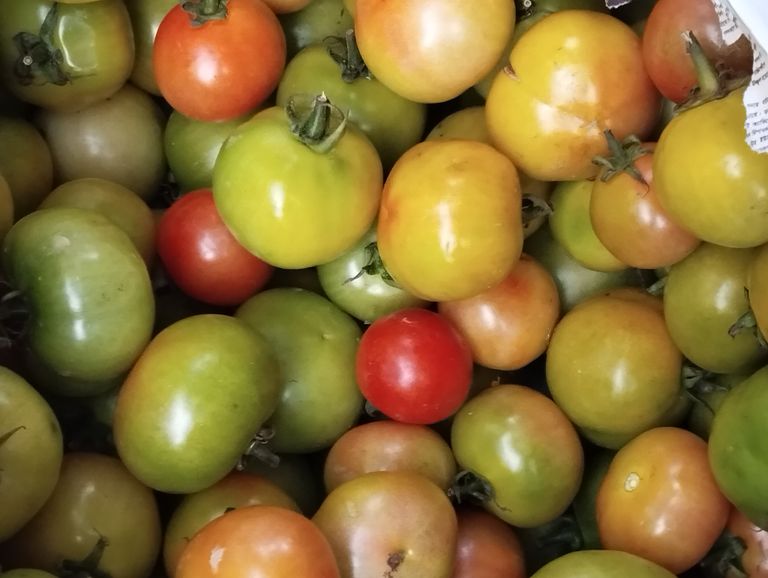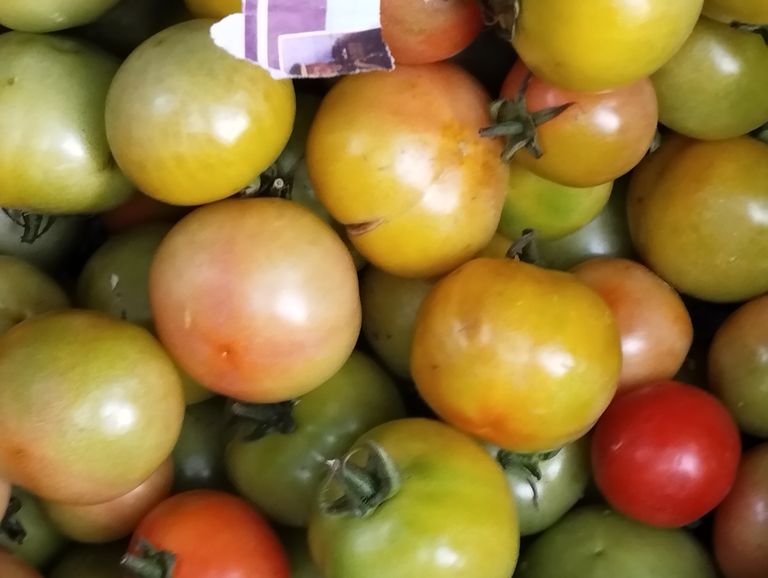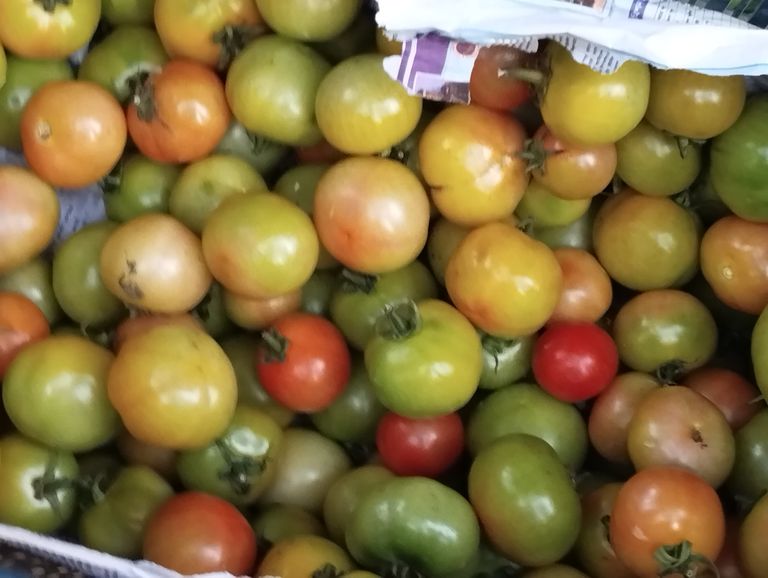
Tomato Salad Recipe A Delicious and Nutritious Dish.
Tomato salad is a simple yet flavorful dish that adds a refreshing touch to any meal. Packed with vibrant colors and rich in nutrients, this salad is perfect for a light lunch, a side dish, or a healthy snack. Here's everything you need to know about making the perfect tomato salad at home.
Why Choose Tomato Salad?
Tomatoes are not only delicious but also a powerhouse of vitamins and minerals. Rich in vitamin C, potassium, folate, and antioxidants like lycopene, they support heart health, improve skin, and reduce the risk of chronic diseases. A tomato salad combines these benefits with a burst of flavor, making it an excellent choice for health-conscious individuals.
Ingredients for a Classic Tomato Salad
To prepare a simple yet tasty tomato salad, you’ll need:
Fresh Tomatoes: Choose ripe, juicy tomatoes for the best flavor. Cherry, grape, or heirloom tomatoes work well.
Onion: Red onions add a mild sweetness and a crisp texture.
Cucumber: Optional but adds a refreshing crunch.
Olive Oil: Extra virgin olive oil enhances the flavor.
Vinegar or Lemon Juice: Adds a tangy twist.
Herbs: Fresh basil, parsley, or cilantro for aroma and flavor.
Seasonings: Salt, black pepper, and optional red chili flakes for a hint of spice.
Step-by-Step Instructions
Step 1: Prepare the Ingredients
- Wash the tomatoes thoroughly under running water.
- Slice the tomatoes into wedges or halves if using cherry tomatoes.
- Thinly slice the red onion and cucumber (if using).
Step 2: Mix the Salad
- In a large bowl, combine the sliced tomatoes, onion, and cucumber.
- Drizzle olive oil generously over the vegetables.
- Add vinegar or lemon juice to enhance the tanginess.
Step 3: Add Seasonings and Herbs
- Sprinkle salt and freshly ground black pepper to taste.
- Toss in chopped herbs like basil or parsley for added freshness.
Step 4: Toss and Serve
- Gently toss the salad to ensure all ingredients are well mixed.
- Let it rest for 5–10 minutes to allow the flavors to meld.
- Serve immediately or refrigerate for later.
Variations of Tomato Salad
- Mediterranean Style
Add crumbled feta cheese, olives, and a dash of oregano for a Mediterranean twist.
- Caprese Salad
Layer slices of tomatoes with fresh mozzarella and basil leaves, then drizzle with balsamic glaze.
- Spicy Tomato Salad
Incorporate chopped green chilies or jalapeños and a sprinkle of paprika for a spicy kick.
- Avocado-Tomato Salad
Add diced avocados for a creamy texture and extra nutrients.
Tips for the Best Tomato Salad
Use fresh, in-season tomatoes for optimal flavor.
Avoid refrigerating tomatoes before use, as it can diminish their taste.
Let the salad sit for a few minutes after preparation to enhance the flavors.
Health Benefits of Tomato Salad
- Rich in Antioxidants: Tomatoes are loaded with lycopene, which helps combat free radicals.
- Heart Health: Olive oil and tomatoes contribute to reducing bad cholesterol levels.
- Low-Calorie Dish: Perfect for those watching their weight.
- Hydration: High water content keeps you hydrated.
Tomato salad is a versatile, healthy, and delicious dish that can be tailored to your taste preferences. Whether you prefer it plain, spicy, or with a Mediterranean flair, it’s a wonderful addition to your culinary repertoire. Try making it today and enjoy the burst of freshness it brings to your meals!

Tomato-Based Small Fish Curry Recipe
Small fish curry is a traditional and flavorful dish that combines the tenderness of small fish with the tanginess of tomatoes. It’s easy to prepare and pairs perfectly with steamed rice. Below is a step-by-step recipe to make a delicious tomato-based small fish curry.
Ingredients
For the Small Fish:
250 grams of small fish (e.g., anchovies, sprats, or any local variety)
1 teaspoon turmeric powder
1 teaspoon salt
2 tablespoons mustard oil or any vegetable oil
For the Curry:
3 medium-sized tomatoes, finely chopped
2 medium-sized onions, thinly sliced
2-3 green chilies, slit lengthwise
1 teaspoon ginger-garlic paste
1 teaspoon cumin seeds
1 teaspoon coriander powder
1/2 teaspoon red chili powder (optional)
1/2 teaspoon turmeric powder
1/2 teaspoon garam masala powder
2-3 tablespoons mustard oil (or your preferred cooking oil)
Fresh coriander leaves, chopped (for garnishing)
Salt to taste
Preparation
Step 1: Cleaning the Fish
- Wash the small fish thoroughly under running water.
- Marinate them with turmeric powder and salt. Let it sit for 10-15 minutes.
Step 2: Frying the Fish
- Heat mustard oil in a pan until it starts smoking slightly (this reduces the pungency).
- Add the marinated fish and fry on medium heat until golden brown. Remove and set aside.
Cooking the Curry
Step 3: Preparing the Base
- Heat oil in a pan.
- Add cumin seeds and let them splutter.
- Add the sliced onions and sauté until they turn golden brown.
- Stir in the ginger-garlic paste and cook for another 1-2 minutes until the raw smell disappears.
Step 4: Adding Tomatoes and Spices
- Add the chopped tomatoes to the pan. Cook until they soften and turn mushy.
- Add turmeric powder, coriander powder, red chili powder, and salt. Mix well.
- Cook on medium heat until the oil separates from the masala.
Step 5: Combining the Fish
- Gently add the fried fish to the pan.
- Mix carefully, ensuring the fish doesn’t break apart.
- Add a splash of water if you prefer a slightly runny curry.
- Cover and simmer for 5-7 minutes to allow the flavors to meld together.
Step 6: Finishing Touch
- Sprinkle garam masala and stir gently.
- Garnish with freshly chopped coriander leaves.
Serving Suggestions
Serve this tomato-based small fish curry hot with steamed rice or roti. For a more authentic experience, pair it with a side of fresh salad or pickles.
Tips and Variations
Fish Variety: You can use any small fish available locally.
Spice Level: Adjust the number of green chilies and red chili powder based on your spice preference.
Vegetables: Add diced potatoes or brinjal (eggplant) for extra texture.
Healthier Option: Instead of frying, you can steam or lightly sauté the fish.

How to Make Fresh Tomato Juice at Home: A Complete Guide
Tomato juice is a refreshing and nutrient-rich beverage that offers numerous health benefits. Packed with vitamins, minerals, and antioxidants, it’s a great addition to your diet. Whether you’re looking for a healthy morning drink, a base for soups and cocktails, or a revitalizing afternoon pick-me-up, tomato juice is a versatile option. Here's a comprehensive guide to making fresh tomato juice at home.
Why Drink Tomato Juice?
Tomatoes are a powerhouse of nutrients. Tomato juice is:
- Rich in Antioxidants: Contains lycopene, which helps combat oxidative stress and promotes skin health.
- Low in Calories: Perfect for weight watchers.
- Boosts Immunity: Loaded with Vitamin C and essential minerals.
- Improves Heart Health: High in potassium and supports blood pressure regulation.
Ingredients
To make fresh tomato juice, you’ll need:
4-5 medium-sized ripe tomatoes
1/4 teaspoon salt (optional)
1/4 teaspoon black pepper (optional)
1 teaspoon lemon juice (optional)
1/4 cup water (if required)
Optional Add-ins:
A pinch of sugar for sweetness
Fresh basil leaves for added flavor
Step-by-Step Recipe for Tomato Juice
Step 1: Choosing the Tomatoes
Use ripe, juicy, and fresh tomatoes for the best flavor.
Roma or plum tomatoes are ideal because they are less watery and have a richer taste.
Step 2: Washing and Preparing
Wash the tomatoes thoroughly under running water to remove dirt and pesticides.
Remove the stem and cut the tomatoes into quarters.
Step 3: Blending
Place the tomato pieces in a blender or food processor.
Blend until smooth. If the mixture is too thick, add a small amount of water to achieve your desired consistency.
Step 4: Straining
Use a fine mesh strainer or cheesecloth to separate the juice from the pulp.
Press down with a spoon or squeeze the cloth to extract maximum juice.
Step 5: Flavoring
Pour the strained juice into a bowl or jug.
Add salt, black pepper, and lemon juice to enhance the taste. Mix well.
Step 6: Serving
Serve the juice immediately over ice cubes or chill it in the refrigerator before serving.
Health Benefits of Tomato Juice
- Rich in Nutrients
Tomato juice is an excellent source of vitamins A, C, and K, as well as essential minerals like potassium and magnesium.
- Promotes Hydration
Tomatoes have a high water content, making this juice perfect for staying hydrated.
- Supports Skin Health
Lycopene and Vitamin C in tomato juice improve skin elasticity and reduce signs of aging.
- Boosts Digestive Health
Tomato juice aids digestion and helps prevent constipation due to its fiber content.
- Heart-Friendly
Its potassium content helps regulate blood pressure, reducing the risk of cardiovascular diseases.
Variations of Tomato Juice
- Spicy Tomato Juice
Add a pinch of cayenne pepper or Tabasco sauce for a spicy kick.
Garnish with celery sticks for a savory touch.
- Herbal Tomato Juice
Blend fresh basil, cilantro, or mint leaves with the tomatoes for an aromatic twist.
- Tomato Smoothie
Mix tomatoes with other fruits like watermelon or strawberries for a refreshing smoothie.
Storing Tomato Juice
Refrigeration: Store fresh tomato juice in an airtight container for up to 3 days.
Freezing: Freeze in ice cube trays and use them later in recipes or as refreshing drink cubes.
Uses of Tomato Juice
- As a Drink
Enjoy it plain or use it as a base for mocktails and cocktails like Bloody Mary.
- In Cooking
Tomato juice can be used in soups, stews, and curries to enhance the flavor.
- Skin Care
Apply fresh tomato juice to your skin for a natural glow and to reduce blemishes.
Tips for Perfect Tomato Juice
Always use fresh and ripe tomatoes for the best taste.
Adjust the salt and pepper to suit your palate.
If you prefer a thicker texture, skip the straining step.
Tomato juice is more than just a drink—it’s a versatile ingredient and a health booster. Whether you’re sipping it as a refreshing beverage or using it in recipes, its tangy flavor and nutritional benefits are sure to make it a favorite in your kitchen.
Common Diseases of Tomato Plants and Their Management
Tomatoes are one of the most widely grown vegetables in the world, but they are also susceptible to a variety of diseases. These diseases can significantly affect the yield and quality of the crop, making it essential for farmers and gardeners to understand the common problems and how to manage them effectively.
- Early Blight (Alternaria solani)
Early blight is a fungal disease that affects tomato plants, particularly during warm and humid conditions.
Symptoms:
Dark, concentric rings on older leaves
Yellowing and premature defoliation
Lesions on stems and fruits
Management:
Use disease-resistant varieties.
Rotate crops and avoid planting tomatoes in the same soil every year.
Apply fungicides like chlorothalonil or copper-based sprays.
- Late Blight (Phytophthora infestans)
Late blight is a devastating disease, especially in wet and cool climates. It was responsible for the infamous Irish Potato Famine and can also severely damage tomato crops.
Symptoms:
Water-soaked lesions on leaves and stems
Whitish fungal growth under leaves during high humidity
Rapid decay of fruits
Management:
Ensure good air circulation and avoid overhead irrigation.
Remove infected plants immediately.
Use fungicides such as mancozeb or metalaxyl.
- Septoria Leaf Spot (Septoria lycopersici)
This fungal disease primarily affects the leaves and can lead to defoliation if not controlled.
Symptoms:
Small, round spots with dark borders and gray centers on lower leaves
Leaves turn yellow and fall off
Management:
Remove affected leaves and ensure proper spacing between plants.
Apply fungicides like chlorothalonil or neem oil.
Practice crop rotation.
- Tomato Mosaic Virus (ToMV)
This virus is easily spread through infected seeds, soil, and tools.
Symptoms:
Mottled yellow and green leaves
Stunted growth
Deformed fruits
Management:
Use certified disease-free seeds.
Disinfect tools and avoid handling plants when wet.
Remove and destroy infected plants.
- Bacterial Wilt (Ralstonia solanacearum)
This soil-borne bacterial disease causes sudden wilting in tomato plants.
Symptoms:
Wilting of leaves, often during the day
Brown discoloration in the vascular system of the stem
Management:
Avoid planting in areas with a history of bacterial wilt.
Use resistant varieties and practice crop rotation.
Solarize soil to reduce bacterial populations.
- Fusarium Wilt (Fusarium oxysporum)
Fusarium wilt is a fungal disease that thrives in warm, sandy soils.
Symptoms:
Yellowing of leaves, often on one side of the plant
Wilting and eventual death of the plant
Brown streaks in the stem
Management:
Use resistant tomato varieties.
Rotate crops and improve soil drainage.
Apply fungicides if necessary.
- Powdery Mildew
This fungal disease affects tomatoes, especially in dry conditions with high humidity.
Symptoms:
White, powdery spots on leaves and stems
Leaves may turn yellow and drop
Management:
Improve air circulation by pruning.
Avoid overhead watering.
Apply sulfur-based fungicides or potassium bicarbonate.
- Root-Knot Nematodes (Meloidogyne spp.)
These microscopic pests attack the roots, causing significant damage.
Symptoms:
Swollen, knot-like galls on roots
Stunted growth and yellowing of leaves
Management:
Use nematode-resistant varieties.
Rotate crops with non-host plants like corn or beans.
Incorporate organic matter to improve soil health.
General Tips for Tomato Disease Prevention
Plant Resistant Varieties: Look for varieties labeled as resistant to specific diseases.
Maintain Garden Hygiene: Remove weeds and debris where pests and pathogens can thrive.
Optimize Growing Conditions: Provide adequate sunlight, spacing, and well-draining soil.
Use Organic Practices: Apply compost and mulch to promote healthy growth and suppress diseases.
Regular Monitoring: Inspect plants regularly to detect diseases early.
Marketing Tomatoes: A Comprehensive Guide
Tomatoes are among the most versatile and widely consumed vegetables globally. They are used in countless dishes and processed into sauces, juices, and other products. Successful tomato marketing requires a well-planned strategy that considers production, packaging, distribution, and pricing. This blog provides a comprehensive guide to marketing tomatoes effectively.
- Understanding the Tomato Market
Tomatoes have a consistent demand due to their role in various cuisines and processed products. The market can be segmented into:
Fresh Market: For direct consumption.
Processing Industry: For making ketchup, sauces, and canned products.
Specialty Tomatoes: Cherry, heirloom, or organic varieties targeting niche markets.
- Key Factors Affecting Tomato Marketing
Several factors influence tomato marketing:
Quality: Fresh, blemish-free tomatoes attract premium prices.
Shelf Life: Tomatoes with longer shelf life reduce losses during transit and storage.
Seasonality: Off-season tomatoes often fetch higher prices.
Consumer Preferences: Demand for organic or locally grown tomatoes is rising.
- Steps to Market Tomatoes Effectively
A. Production Planning
Understanding consumer demand and market trends is essential. Farmers should focus on:
Selecting high-yield, disease-resistant varieties.
Implementing modern farming techniques to ensure consistent quality.
Using sustainable practices to appeal to eco-conscious consumers.
B. Grading and Sorting
Tomatoes should be graded based on size, color, and quality. Proper sorting enhances the visual appeal, making them more marketable.
C. Packaging
Packaging is vital to protect tomatoes during transit and attract buyers.
Use ventilated boxes to maintain freshness.
Ensure eco-friendly and visually appealing packaging for premium markets.
D. Branding
Creating a unique brand identity can set your tomatoes apart.
Highlight unique selling points like organic production or farm-to-table freshness.
Use attractive labels and emphasize certifications (e.g., organic, non-GMO).
E. Distribution Channels
Choosing the right distribution channels is key:
- Local Markets: Ideal for small-scale farmers.
- Supermarkets and Grocery Chains: Require bulk supplies and consistent quality.
- Online Platforms: Growing demand for fresh produce via e-commerce platforms.
- Export Markets: Target international markets for higher profits.
F. Marketing Strategies
Social Media: Showcase your farm and products through platforms like Instagram and Facebook.
Farmers’ Markets: Build a direct relationship with customers.
Collaborations: Partner with restaurants or food processors for steady demand.
Promotions: Offer discounts, free samples, or loyalty programs to attract customers.
- Challenges in Tomato Marketing
A. Perishability
Tomatoes are highly perishable. To combat this:
Use cold storage facilities.
Transport in temperature-controlled vehicles.
B. Price Fluctuations
The price of tomatoes can vary significantly due to weather, supply, and demand. Mitigate risks by:
Diversifying crops.
Exploring contract farming options.
C. Competition
High competition requires a focus on quality, branding, and customer service.
- The Role of Technology
Technology can enhance marketing efficiency:
Precision Farming: Improve yield and quality.
E-commerce: Reach a wider audience.
Mobile Apps: Connect farmers directly with buyers, reducing middlemen.
- Exporting Tomatoes
Exporting offers lucrative opportunities but requires meeting stringent standards. Focus on:
Complying with international quality certifications.
Understanding import regulations of target countries.
Efficient logistics and cold chain management.
- Government Support and Policies
Many governments provide subsidies, training, and market access to support tomato farmers. Stay updated on policies and take advantage of available schemes.
Effective tomato marketing combines quality production, efficient logistics, strategic branding, and leveraging technology. By understanding market dynamics and adapting to consumer preferences, tomato growers can maximize profitability and ensure sustainable growth.